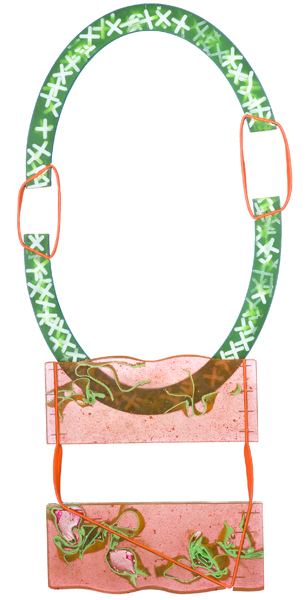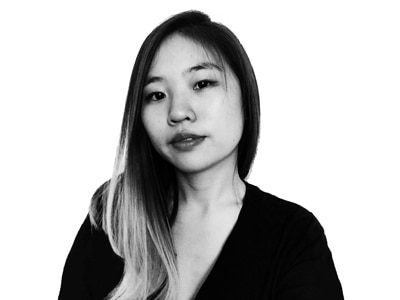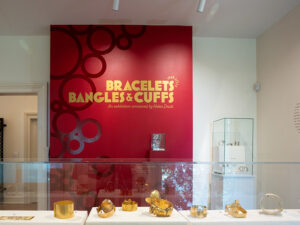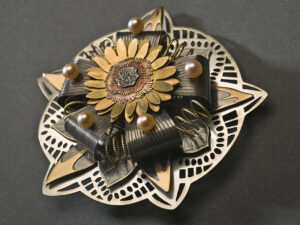Olivia Shih: You hold a BA in fashion and design from the University of Art and Design Linz, in Austria, and you’re working toward a MFA degree at the University of Applied Sciences in Trier, Germany. Could you talk about your background and education and how they have influenced your work?
 Stephie Morawetz: Actually, it all began when I was seven years old. My grandmother died when I was four, and I never really knew her. My mother always told me stories about her. She was a tailor and designed some of the most fantastic clothes for my mother. My mother also told me that my grandmother was a powerful woman and at the same time got on incredibly well with people. Everyone keeps telling me that I inherited a lot from her. So I made the decision to go into fashion.
Stephie Morawetz: Actually, it all began when I was seven years old. My grandmother died when I was four, and I never really knew her. My mother always told me stories about her. She was a tailor and designed some of the most fantastic clothes for my mother. My mother also told me that my grandmother was a powerful woman and at the same time got on incredibly well with people. Everyone keeps telling me that I inherited a lot from her. So I made the decision to go into fashion.
I arrived at Linz with the firm intention to study fashion. But in my first semester, I got to know the field of millinery. In this department, everything was possible at once. You could use any materials and at the same time work three-dimensionally. I fell in love with the manufacture of hats.
I soon realized that millinery is jewelry, but limited to a specific place on the body. With this knowledge and the need to learn more about jewelry, I decided to go abroad.
In the end, the decision to study in Idar-Oberstein was pure gut instinct. When I Googled jewelry and study, the first images I saw were the works of students from Idar-Oberstein. Then it was clear to me: That’s what I want to do!
So I came to Idar-Oberstein and this has been the biggest influence on me.
Idar-Oberstein is a small town in Germany, and there is not much more there than gemstones. But it’s the meeting point of different cultures and different people, and it has the biggest cultural variety I’ve ever seen. All this takes place in the 20-square-meter kitchen of our university. The students come from diverse cultures, all over the Earth, and suddenly politics and race are no longer relevant. Everyone is equal, because we all have the same goal. In my time here, I have learned so many different traditions and cultures, and this is reflected in my work.
The feeling for the body and the need to work with it, this I learned in Vienna. The abundance of colors and shapes is my world here in Idar-Oberstein.
Could you talk about your philosophy behind this collection?
Stephie Morawetz: Our society, the one in which we live, has invented an entirely new material. A material that has been artificially created by mankind and that nature cannot absorb. For almost two centuries, we have been developing this material continuously. It is chemically manufactured in laboratories and is constantly developing, receiving new characteristics. Characteristics that make it more and more difficult for nature to process. Hardly anyone knows the composition of the different types of material. But we all use it daily. It can be found everywhere, and is used in almost all areas of life. Life without this material is hard to imagine.
We produce it from fossil fuel, a material that is becoming increasingly rare. Even with the knowledge that it will disappear one day, we handle it carelessly. We dispose of it by simply throwing it away carelessly, as if nature can absorb it. Nature is sick of this material, and creatures die from it.
Meanwhile, a layer of this material has covered our Earth. Even a new continent has formed.
We live in the plastic age.
Your work is flooded with bright, sometimes neon colors, reminiscent of street wear and pop art. What inspires this vivid color palette and aesthetic?
Stephie Morawetz: I see my work in the future. Even the stone that I have created is from the future. The future, as I see it, is full of colors and reflects this mix of cultures. It is a fact that we diversify more and more. The world nowadays is very small. In the future you will afforded the opportunity to live wherever you want and choose your culture by personal preference. I see the future as colorful, and liken the variety of patterns to the mixture of cultures.
Many of your pieces in Night and Day are oversized and read as explosions of personality and color when worn on the body. What kind of role does scale have in your jewelry?
Stephie Morawetz: The size of my pieces has two reasons. Probably the most important is that I think in the future there will be no fear about wearing jewelry. For me, you should wear jewelry seriously. You should show this seriousness and be proud of it. I think jewelry subsidizes our personality and should therefore be visible. In our society, it’s already accepted that woman can wear big jewelry. With men, this isn’t the case. Most of my pieces are designed for men. I believe that men in the future will also wear jewelry: It should be visible and serious.

Rubber, magnets, stone, and rubber bands are a few of materials you use in constructing your jewelry, which at times feels like whimsical assemblage and at times is as precise as ballet. How did you choose these materials?
Stephie Morawetz: We create plastic from fossil fuel, which is a limited resource. Experts have calculated 40 years for the final consumption of this fossil fuel. Our society uses this material as if it is infinitely available, while in reality it’s only a matter of time until it’s totally exhausted.
I have assumed there is no oil in the future. Through this disappearance, there will be a shift in values, and plastic will be the most valuable material. Rubber, rubber bands, and reconstructed materials (recon) are all plastics. In my work I have tried to use only plastic, as it will be the most valuable material. We can see throughout history that value is related to availability. Plastics will be rare because of the exhaustion of crude oil. The plastics I used for my stone are only upcycled plastics. It’s plastic taken from my daily life. Plastic that we frivolously use and throw away without realizing its value.
In particular, you’ve created a new “stone,” reconstructed from what seems to be non-biodegradable plastic. What inspired the creation of your own material?
Stephie Morawetz: The idea for my material was when I first heard of a newly created island. An island of plastic garbage floats in our ocean; it has now attained 16 times the size of Austria. This shocked me so much that I started to collect everything plastic that accumulates in my daily life. When my room filled slowly, I realized how much plastic we actually use. The problem of different chemical compositions and the fact that companies don’t divulge their “recipes,” which makes plastic rarely recyclable. So what happens with all this plastic waste? Looking at all the landfills, the oceans, or, if you just take a walk through the forest, you have the answer. So if we put a layer of plastic over our planet, something must happen with it.
In my theory, nature uses this artificial material to create something new. A stone with plastic inclusions, plastics that we throw away without thinking about the consequences. My stone is not an assemblage of found plastics; it shows the impact on the future we are already creating now.
My pieces are cut out of a new stone called Stephie Stone. The Stephie Stone is a material from the future. Plastic is not biodegradable, it is simply crushed, and seeps into the ground. So with time and with great pressure, the earth could potentially create a completely new stone. Just like the rutile needles in quartz crystal, the future will see stones that have plastic inclusions.

Where do you see your work going next?
Stephie Morawetz: I see my work becoming more and more political. I want to make visible and raise awareness of the fact that we are already creating our future. Everything we do has an impact, whether positive or negative.
Do you have any suggestions for recent graduates of art jewelry on how to continue making work and on finding representation?
Stephie Morawetz: I would suggest finding what you love and sticking with it.
In our field you won’t get rich or even make a living from it. But don’t stop doing what you love even when you can plaster a wall with rejections.
Have you heard, seen, or read anything of interest lately?
Stephie Morawetz: A lot of things inspire me every day, even the most ridiculous things, like a strangely shaped fruit. But the thing that touched me most recently was poetry from a Palestinian writer: The Dice Player, by Mahmoud Darwish. After all he went through, he could have decided to hate the world, but his poetry is full of hope. Everything comes by chance, but it’s your decision what you do with it.




